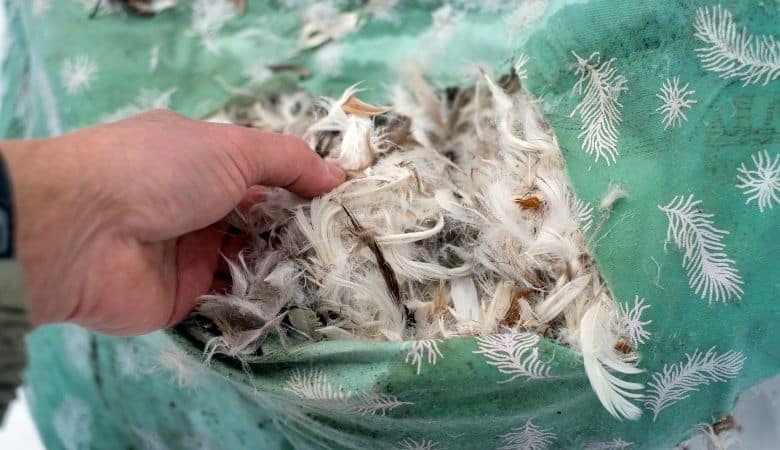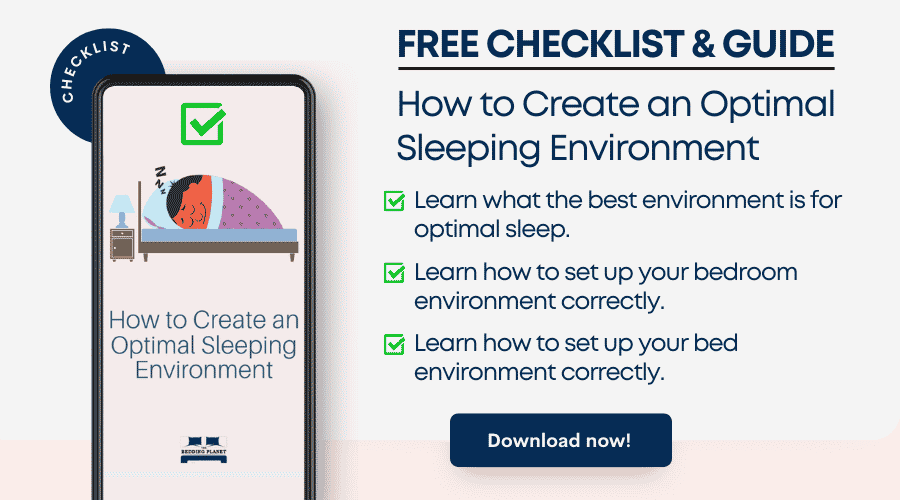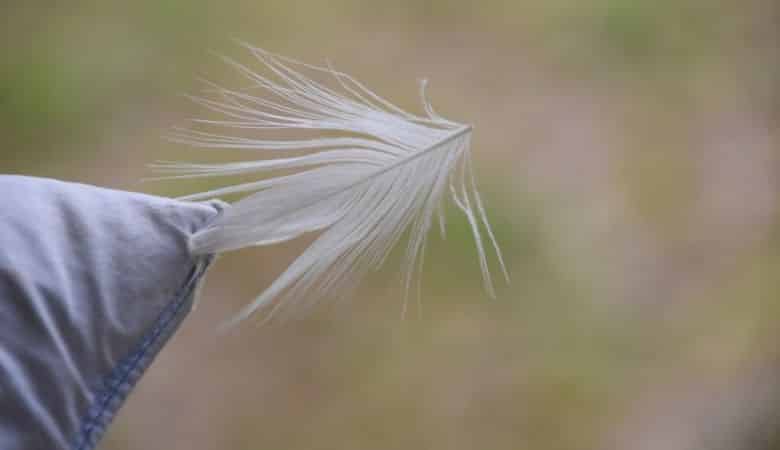This post is part of the complete feather pillow buyers guide
Feather pillows are considered superior to other pillows because they are fluffy, soft, and pliable. But, there’s one thing that a lot of people find annoying with feather pillows. Which is the never ending leaking of feathers…
But, be annoyed no more. There are a few things you can do to prevent your pillow from leaking feathers and maintain its structure and luxuriousness. In this post, we will be guiding you on what you should do to stop feathers from falling out from your pillow.
Quick guide to stop your pillow from leaking feathers:
- Use a pillow protector to avoid the feathers from falling out.
- To keep your pillow fluffy and soft, avoid washing frequently.
- Carefully check your seams for any leaks that you can patch up.
- Please do not use your feather pillow for pillow fights since it quickly damages your pillow.
Stopping your pillow from leaking feathers will take more than the standard practices we have detailed above. In this post, we will give in-depth information on how you can protect your pillow to avoid leaking of feathers.

My Pillow is Leaking Feathers. Does That Mean it is Damaged?
It is common for feathers to come out of your pillow after using it for a while. This can be annoying and worrying since it reduces the pillow’s density eventually. Before you declare your pillow to be a damaged good and get a new one, try out a few simple methods that can stop the leakage and keep your pillow in good condition for a long time.
It may appear that buying a new pillow is much easier than taking care of a pillow you have been using. But as humans, we tend to be attached to what we own, and let go of something we paid the price for is sometimes hard.
How to Stop Your Pillow From Leaking Feathers
1. Use a Pillow Protector
Using a pillow protector is the best way to hold your feathers in the pillow where you need them. Having a pillow protector is not a waste of time, neither is it adding just another piece of coverage to your pillow.
Unlike regular pillow covers, pillow protectors are built with fabric technology that offers more health and comfort benefits. Using a pillow protector is beneficial since it is made of a thick, tightly woven fabric that stops the feather from poking out of the pillow.
The feathers will poke out of the main pillow cover, but they will not poke out any further past the pillow protectors. You can still use a pillowcase over a feather-down pillow with a pillow protector. It is essential for keeping your pillow clean for a long time without the need to wash it frequently.
Sometimes people use plastic covers to line their pillows before placing the covers. This works, but it does not hold for a long time. After you have used your pillow for some time, the plastic gets damaged and can quickly form holes. The pillow feathers will start poking out through the holes, leaving you with leaking feathers. Hence, a protector is a more sensible solution.
2. Take care of your pillow
The tag on your pillow might indicate that your pillow is machine washable. However, this does not guarantee that your pillow will maintain its look and feel like it was before the washing. It is essential to balance the load to keep your pillow in good condition after machine washing.
When you buy a new pillow, you do not pay so much attention to keeping it in better condition as you would for a pillow showing signs of wearing. Always take care of your new pillows so that they can stay in good condition and last longer in the long run.
The first thing you can do is getting a pillow protector to keep the pillow new and fluffy even when used for a while. Treat your pillow the same way you would a pillow that is almost leaking.
3. Do not wash your pillow frequently
Washing pillows once in a while is necessary for many reasons. Just like your bed sheets and blankets, pillows get dirty and can harbor bacteria. Regular washing of pillows keeps them clean and with a fresh smell all through.
The fabric on your pillow wearing out is unavoidable, and washing somewhat contributes to the damage. The wear and tear is also likely to happen even when you do not wash your pillow. It is therefore, essential to follow label instructions when washing your pillow. Wash your pillow twice every year unless labeled “dry clean only.” Washing your pillow is very easy, though it might take longer before it dries.
However, this does not mean that washing often will quickly lead to your feathers sticking out and leaking. Washing pillows frequently will weaken the pillow material, and it will cause your pillow feathers to leak.
4. Fluff your pillow
Fluffing a pillow is necessary for sorting out the feathers. Fluffing will push feathers into place when they are about to pop out of the pillow. Make it a practice of fluffing your pillow once every day, and not when it gets flat. A quill is likely to leak out from the pillow at any moment, so you must spare a few seconds to fluff the pillow and lower the chances of a feather coming out when you are using it.
Drying is the quickest way to fluff your pillows. This can be done by leaving the pillows out in the sun on a clear day. Fluff them multiple times and turn them after an hour or two for exposure of both sides. Do not be extremely rough with the pillow when fluffing. You might push out feathers when applying too much pressure.
When fluffing your pillow in a dryer, the best way to do it is by inserting two tennis balls in the dryer. This way, the balls can beat out any feathers clumped in the pillow as the dryer spins. If you cannot find any tennis balls with you, you can place flip-flops or a clean pair of light shoes.
However, if you only need to use the dryer without any additions, you must set it to air-dry only. When there is too much heat in the dryer, your feather fillings may burn, or absorb an unpleasant smell. Set your timer to ten minutes and do not go beyond that. Air drying also removes any moisture trapped in the pillows, which is good for preventing mildew growth in the down fillings.
5. Patch any leaks

There are many ways to make your pillow usable for a long time and stop feather leaks. One thing to do is find out any holes where feathers are falling off from and patch it. Do this regardless of the size of the tear, whether it is a worn-out spot, a ripped seam, or a minor tear.
Make it a habit to never ignore any spot on the pillow that would use some patching, even the smallest hole. By carrying out regular minor repairs, you are avoiding potential problems in the future.
You will need simple tools like a sewing needle, a thread, and a piece of fabric. If the area that needs patching is big enough, ensure that you have enough material to cover the region wholly. If only the seam is ripped and needs repair, sew together the two joining sides.
It does not necessarily mean that you should have any fancy sewing supplies or sewing experience. Provided you have a thread and a sewing needle, you are all set. You can begin by looking at different hand-sewing styles to understand what pattern is suitable for patching the pillow.

What Should I do if my Couch Cushion is Leaking Feathers?
If your couch cushions are filled with down feathers, you might think that fixing a leakage is difficult, but we are here to remind you that it is the same situation as having feather or down pillows. Couch cushions have two layers, similar to a pillow with a pillowcase.
Most cushions have a zipper on the side that lets you access the pillow inside. However, some cushions have zippers that are hard to locate, so you need to check along the seams at the sides of your cushion. Some zippers are hidden to prevent them from undoing accidentally.
If your couch has cushions with no zippers, you will need to rip along the seam to open it. But before you do this, you need to understand that sewing back the seams is not an easy task, so approach with caution.
Once the cushion is open, you can take out the inner pillow with the feathers. It looks like the typical down pillow you use in your bed. You will then get a pillow protector to secure the feathers and prevent them from leaking. If you cannot find a pillow protector that would fit your seat cushions, you may need fabric material to sew a thick and tight protector.
If you are unsure about sewing a proper pillow protector, you should find a tailor who can easily make one that serves your needs.
How do I Protect my Feather Pillow From Leaking in the Future?

The first preventive measure to protect your pillow from leaking feathers is regularly checking it. By checking regularly, you can catch any openings on the seam or tears before they become too big.
You can start by reinforcing the seams since this is where the leaks are likely to start. The quills on the feathers tend to poke your pillow material, and over time, they can damage the pillow entirely.
If your pillow does not have any holes or rips on the seams, you will need to do some stitching for reinforcement. You can add stitches onto the original seams and the connecting parts of the fabric. This way, your feathers will be held in even as your pillow wears and tears from daily usage.
A pillow protector is also good reinforcement for your new down pillow since they are tightly woven to prevent quills from poking out. Even if your original pillow liner has some tears and lets out feathers, they will be held inside the pillow protector.
The last practice you need to carry out regularly to protect your feathers is maintenance. The best way to maintain your pillow is by regularly fluffing since it helps to distribute the feathers inside the pillow to avoid leaking evenly.
By fluffing, you are also repositioning the feathers. Thus the quills will no longer protrude from the pillow liner. Besides, you also get to maintain your pillow’s fluffiness and softness, which means you get better sleep from this simple practice.
What Should I Look For When Buying a Feather Pillow?
Cambric cotton
A pillow with a cover made from cambric cotton is durable and is tightly woven like a pillow protector. The thick material and tight weave prevents any feathers from popping out the pillow’s surface. You could also add a pillowcase over the pillow to be sure.
Knife-edge seams
The weakest points of pillows are the seams and edges. Most leakages and holes start to develop at the edges, so ensure yours has firmly stitched edges. Cheap pillows do not have edges, only threads to connect the outer fabric. The best edges to look for in a pillow are the knife-edge seams or piped seams.
Even if a feather pillow is nicely made with piping or knife-edge seams, you still need to ensure that it is well made. This way, you get a pillow with fewer chances of leaking feathers and gives you the best sleep. It also keeps your bedding looking excellent and organized.
Conclusion
Feather pillows are soft and breathable, making them the best choice if you want to sleep better. However, it would help if you took preventive measures to avoid feathers falling off from your pillow and losing its structure in the long run.
You can regularly check for any damages and patch them before they become hard to control. If the feathers on your pillow are already leaking and you want to prevent further leaks, you can follow the guide to find the best methods to change your feather pillow’s condition.
Feather Pillows: A complete buyers guide – Parts:
1. Why Should You Use A Feather Pillow? The pros and cons
2. Down vs. Feather Pillows: What’s the difference and which is better?
3. How Long Do Feather Pillows Last? This is the replacement time
4. How to Wash And Dry a Feather Pillow: Step by step guide
5. How to Stop Your Feather Pillow From Leaking Feathers
6. Best Feather Pillows of 2021 – Full Guide and Review



